Our "Roots" Trip to Częstochowa
by GIL CHEN (Israel)
This was a trip that penetrated deep into the heart and the soul. That was the feeling at the end of a short trip to Poland at the end of October 2012. Neither words, pictures nor videos can transmit the special feeling of a once-in-a-lifetime trip, a return to our roots, to think of the past generations of my family who lived right here, just two minutes walk from our hotel. Right here, just round the corner, how near – how far – and how different!
I will try to share with you those special events that we, myself and our two grown-up children, experienced in two concentrated days in Częstochowa.
It all started with my daughter preparing for a trip to Poland with her school. I realised that this would give me an excellent opportunity to combine this journey with a short “roots” trip, as her journey would end in Katowice, and the city where my father was born was only one and a half hours away from there. This was an opportunity that I was not going to miss. I had to arrange a trip with my grown-up son to collect my daughter at the end of her school journey and to continue on to Częstochowa. This trip had to be well organised, as we only had two days available and our tasks, though not many, were quite involved. We began to prepare. But where to begin?
I gave myself two main objectives – to find the house where my father was born and to find the graves of my relatives in the local Jewish Cemetery. I was curious to learn more about where my ancestors had lived, to try and understand what had happened to them and to feel, primarily, to feel.
Our preparations included several meetings with my father, who told us about his family in Częstochowa and the bitter destiny of most of them. He also showed us a film he had made on his own ‘roots” trip, twenty three years earlier, in which you can see the house where he was born and where his aunt, Gitel Furburg née Silnicki, had lived. The street was named after Giuseppe Garibaldi. No number. Was the house still there? Who lives there today? Was the metal workshop seen in the old film still working? And what happened to the uncle’s butcher shop opposite the house? During weeks before we left, many thoughts constantly ran through my brain.
My father did not know anything about the Jewish cemetery in the town, but put me in touch with key people who provided me with excellent material – Alon Goldman, Chairman of the Association of Częstochowa Jews in Israel and Dina Wiener, who organises the Gidonim project in the Reut High School in Jerusalem. They helped me tremendously and gave me the impression that my journey was important for them as well. I received a lot of material from them and they obtained, for me, many details about the cemetery. I struck it lucky, because the grave of my great-grandfather, Michael Silnicki, who died in 1918, had been ‘discovered’ by the Gidonim students children just the previous year. So there was a good chance that we would find that grave. Moreover, the grave of his brother, Yankel Shilansky, had been documented previously. There was light at the end of the tunnel and our optimism was high. I put all the information into one file. which became our ‘official’ file, so that we would not have to rely on a piece of information, a list, names of graves or photos of gravestones and then realise that we had left them behind in Israel.
A few days before we set out, we were disappointed to hear that a local Pole, the historian Wiesław Paszkowski, who has been researching the cemetery and helping to document and preserve its heritage, would be on vacation whilst we were there and that we would not be able to meet with him. We would therefore have to rely solely on the information which we had received from Dina and Alon. What a shame!
And so here we were, my son and I, already in Warsaw, walking towards the notorious Umschlagplatz, by way of all the markers, till we get there and then on to the Rappaport Memorial. But with all the respect due to this place, and without demeaning it in anyway, my mind is already focussed on the next twelve hours, collecting my daughter from Katowice, arriving in Częstochowa, getting to the cemetery, searching for the graves and for the house.
It’s night. Together with my son and daughter, I have arrived at a small family hotel in Częstochowa. It is situated in an area that was formerly part of the Jewish Ghetto. We are tired out, but nevertheless I connect my computer to the internet and begin to read. A last minute surprise – Alon forwards me a new email just received from the local historian with photographs and additional instructions as to how to locate the graves – but it’s all in Polish. My grateful thanks to the founders of Google, as with the help of their translation programme, we immediately translate it into a somewhat peculiar Hebrew and also save the pictures and the translation onto my daughter’s mobile phone, which is working overtime.
In contrast to the wintry weather and the snow that fell over the previous few days, the weather looks fine in the morning (some more small help “from above” on the way to finding the graves.) The receptionist at the hotel explains to the cab-driver that we wish to get to the Jewish Cemetery, but that he should stop on the way, as we wish to buy some memorial candles. We are nervous, as we know that the next few hours will determine the success or failure of our journey. We really hope that we can find the graves, but who knows in what state we will find the cemetery? Would the material and the explanations that we had previously received be exact enough? Will it be easy to see the divisions between each section? We had been warned that the Nazis had done their best to destroy the cemetery immediately after the invasion of the city, and that the rows inside the cemetery are now not all that straight. Most of the tombstones are buried in the ground, covered in weeds or damaged.
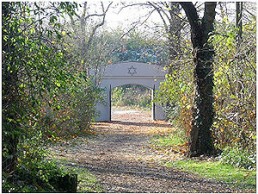
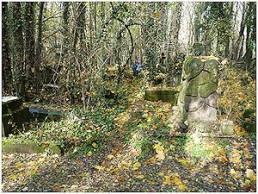
The drive there seems very pastoral, through the narrow forest. Many areas are covered in snow. One more curve and the gate of the cemetery is in front of us. We get out of the taxi and the driver goes on his way. Only the three of us are at the entrance to the Jewish cemetery – us and hundreds of Jewish souls, who had lived in Częstochowa for hundreds of years, lying buried beneath the ground. Right! To work!
We take out our file and read the explanations which we have brought from home and try to match the explanations and theories to the area. We walk along the central path, trying to count the rows of graves. Here is the exposed open area – here are rows of graves on the right and on the left. Here are the trees, all crowded together and here, a bit further along, an area with just odd trees here and there. So where are the graves we’re looking for? We’ve already reached the area of the big mass grave. Only two weeks ago, there was a group here who left wreaths and they are still there, lying in front of the graves. I have a feeling that we should go back a bit. We have passed “our” graves. The bend in the main path is some fifty metres back and, it seems to me that the graves, that what we are looking for should be just before the bend. The actual layout of a place always looks different from the way you imagined it and it is not easy to know where you are, in an unfamiliar place. The historian could really have helped us now and just the week that we’re here, he had decided to take his vacation!
We take out my daughter’s mobile phone and read again what we had received only the night before. “Look for the grave of Jakob Hyelborn on the left and count ten graves along that row.” We look at the picture of Jacob’s grave that we have which, luckily, is unusual and within a few minutes – success! We have found his grave, the first hint that we are on the right track. My son leads the way between the headstones and the graves, along what must once have been a straight line of graves, and we try to count ten plots. Do we count the one which is damaged and lying on its side? Are there one or two other graves under the snow and leaves? Should we take out of the file of the list of graves prepared by the Gidonim and progress according to their list.
My son advances according his understanding and feeling. Count to ten. Surrounding us are a number of graves and headstones. Everything is covered with snow. “Perhaps the grave is to your left”, says my daughter, remembering the photo we had received yesterday evening, showing the gravestone not standing straight. My son clears away the snow and the leaves and reads out the name “Silnicki”. Unbelievable! We have found the grave of the uncle of my paternal grandmother! Amazing! We clean the stone, but cannot find the broken off top part, where his first name would have been written. It is impossible to say how the stone broke and where the grave lies exactly. We light a memorial candle, document it all and find it very moving, above all, very moving.
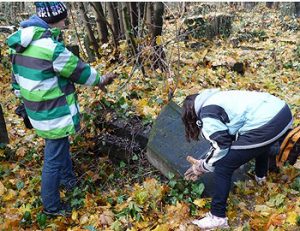 We continue in the same way to look for the other grave. It must be quite near, on the other side of the central path. You don’t change a winning team and our duties remain the same. My son leads and counts the graves. My daughter consults her mobile phone, where we have all the explanations and the photo of the “next hint”. Here is the grave where we have to turn and count thirteen more. We try to progress without treading on the other tombstones and graves. Once again, we clean away the snow and the leaves and….. bingo!! We have found the other grave! I can’t help myself. I don’t forget for a moment that my father is in Israel, and, at this very moment, is certainly waiting anxiously at home for news from us. “Abba, good morning. At this moment, we are standing by the grave of your grandfather, after whom you are named.” I am not normally an emotional person but now I am very moved by it all and there are tears in my eyes. I am sure that, on the other side of the phone line, my father is very moved as well and there, a long way away in Israel, tears are being shed.
We continue in the same way to look for the other grave. It must be quite near, on the other side of the central path. You don’t change a winning team and our duties remain the same. My son leads and counts the graves. My daughter consults her mobile phone, where we have all the explanations and the photo of the “next hint”. Here is the grave where we have to turn and count thirteen more. We try to progress without treading on the other tombstones and graves. Once again, we clean away the snow and the leaves and….. bingo!! We have found the other grave! I can’t help myself. I don’t forget for a moment that my father is in Israel, and, at this very moment, is certainly waiting anxiously at home for news from us. “Abba, good morning. At this moment, we are standing by the grave of your grandfather, after whom you are named.” I am not normally an emotional person but now I am very moved by it all and there are tears in my eyes. I am sure that, on the other side of the phone line, my father is very moved as well and there, a long way away in Israel, tears are being shed.
Here, as well, the tombstone does not appear to be in line with the grave itself, which we cannot positively identify. We light a memorial candle, say Kaddish and take photos of the gravestones from every possible angle. For the benefit of the generations to come, we film the cemetery and how we found the graves.
We leave the cemetery and wait for the taxi. Interim report: 100% success! We found the graves and were very moved by it all. It is sad to see the destruction wrought by the Nazis; sad to see the mass grave in the cemetery and to try and imagine what happened here during the Holocaust. On the other hand, it was exciting to see the fantastic and very special work the Gidonim youth did here – finding graves and tombstones, and then documenting them. I really must thank Alon and Dina as soon as I get back to Israel. In the evening, back at the hotel,I send photos to my father and also update Alon.
A new day dawns. My children are still sleeping. But I cannot wait and I leave the hotel early in the morning, on a wet and wintry day, to search for the house where my father’s family lived. The street is really very near, about 20 meters from the hotel, but where exactly is the house? I walk excitedly down the street and here, a few meters past the corner, is the house – 18 Garibaldi Street (ed: ul.Garibaldiego 18). I couldn’t miss it! Apart from some outside plastering on the first floor, nothing has changed since the photographs I have, taken some twenty years ago. It all looks exactly the same, including the house opposite. The house is deserted, with broken window panes, and is not inhabited at the moment. Shame! I thought I would meet the people living there and that they would invite me in so that I could feel and breathe the house inside. But there is a big sign on the house, a sign that moves me very much:
Here will be built a Jewish Heritage site, which will include a Jewish Cultural Museum, a youth hostel for participants in the March of The Living, a kosher restaurant, a high school for learning Yiddish and Hebrew as well as a gallery and music hall.
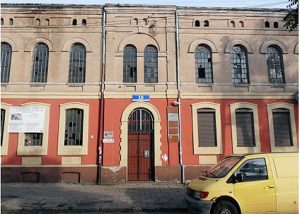
– my grandmother’s family house
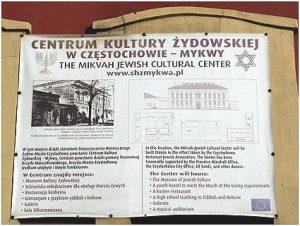
(Webmaster’s note: This sign was put up by someone who had purchased this property several years ago and who hoped to profit from the city’s Jewish past and heritage. The proposed project, not supported by either the Częstochowa City Council nor by the World Society, did not go ahead. Since then, we have seen the creation of the Jewish Museum of Częstochowa – a project supported by both the City Council and the World Society.)
I return to the hotel, wake up my children and tell them about my discovery. I push them to dress and get organised and we go out, again straight to the house. It amazes me that my children and I slept so close to this house where my father was born. Right on this sidewalk, outside this hotel, my grandparents almost certainly pushed my father in his pram. Who would have thought that, just one year later, the Nazis would invade the town? Who would have thought that, more than seventy years later, the grandchildren of that baby would be walking here on these streets?
My children photograph and film everything, climbing up in order to peek through the windows into the deserted and quiet building. The gate to the side entrance is locked. I speak to some young boys who live nearby and who understand English. I show them pictures my father took here, some twenty years ago, and try to find out what happened to the butcher’s shop opposite, which used to belong to my father’s uncle. Apparently, twenty years ago, it turned into an electrical shop. The metal workshop in the house had moved to another place further up the street, but today is a holiday and everything is closed. I show the boys more photos and an old film. They show a great deal of interest in it all. They are amazed that I have documented all this and surely do not comprehend what we are doing, standing next to a dilapidated, deserted house on a cold wet winter morning, and why we came here all the way from Israel. But, to me and my children, the reason is quite clear. This was a once-in-a-lifetime trip for us and, with two successes, it was worth all the preparation and the effort. I feel that we have closed the circle.
In the time left to us, we tour the town, taking in all the places that were connected with its Jewish past and their destiny. In every place, the feeling was “Here my great-grandfather went to synagogue”, “Here, surely, Grandma went for a walk with my dad when he was a baby”, but also “Here my family waited to be collected to be taken to Treblinka” and “Here was the border of the ghetto, beyond which my family could not go”
The journey back to Israel was long and tiring. We longed to be back in our own warm home, to tell everyone about our experiences, to show our photos and films, and to hug my father and to tell him how much I love him.
